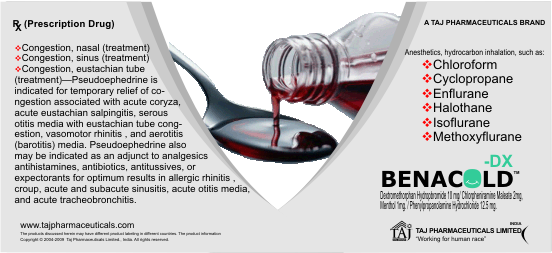|
|
Category
Decongestant, nasal (systemic)—
Indications
Congestion, nasal (treatment),
Congestion, sinus (treatment) or
Congestion, eustachian tube (treatment)—Pseudoephedrine is
indicated for temporary relief of congestion associated with acute
coryza, acute eustachian salpingitis, serous otitis media with
eustachian tube congestion, vasomotor rhinitis , and aerotitis (barotitis)
media. Pseudoephedrine also may be indicated as an adjunct to
analgesics, antihistamines, antibiotics, antitussives, or
expectorants for optimum results in allergic rhinitis , croup,
acute and subacute sinusitis, acute otitis media, and acute
tracheobronchitis.
Mechanism of action
Pseudoephedrine acts on alpha-adrenergic receptors in the mucosa
of the respiratory tract, producing vasoconstriction. The
medication shrinks swollen nasal mucous membranes; reduces tissue
hyperemia, edema, and nasal congestion; and increases nasal airway
patency. Also, drainage of sinus secretions may be increased and
obstructed eustachian ostia may be opened.
Biotransformation
Pseudoephedrine is incompletely metabolized in the liver.
Onset of action
15 to 30 minutes.
Time to peak effect
Within 30 to 60 minutes.
Duration of action
Tablets, oral solution, and syrup—3 to 4 hours.
Extended-release capsules and tablets—8 to 12 hours.
Elimination
Renal. About 55 to 75% of a dose is excreted unchanged. The rate
of excretion is accelerated in acidic urine.

Precautions to Consider
Patients sensitive to other sympathomimetics (for example,
albuterol, amphetamines, ephedrine, epinephrine, isoproterenol,
metaproterenol, norepinephrine, phenylephrine, phenylpropanolamine,
terbutaline) may be sensitive to this medication also.
Pregnancy/Reproduction
Pregnancy—
Studies in humans have not been done.
Studies in animals have not shown that pseudoephedrine causes
teratogenic effects in the fetus. However, pseudoephedrine reduced
average weight, length, and rate of skeletal ossification in the
animal fetus.
Breast-feeding
Pseudoephedrine is distributed into breast milk; use by nursing
mothers is not recommended, because of the higher than usual risk
to infants, especially newborn and premature infants, of side
effects from sympathomimetic amines. {32}
Pediatrics
Pseudoephedrine should be used with caution in infants, especially
newborn and premature infants, because of the higher than usual
risk of side/adverse effects.
Geriatrics
No information is available on the relationship of age to the
effects of pseudoephedrine in geriatric patients. However, elderly
patients are more likely to have age-related prostatic
hypertrophy, which may require adjustment of dosage in patients
receiving pseudoephedrine.
Drug interactions and/or related problems
The following drug interactions and/or related problems have been
selected on the basis of their potential clinical significance
(possible mechanism in parentheses where appropriate)—not
necessarily inclusive (» = major clinical significance):
Note: Combinations containing any of the following
medications, depending on the amount present, may also interact
with this medication.
Anesthetics, hydrocarbon inhalation, such as:
Chloroform
Cyclopropane
Enflurane
Halothane
Isoflurane
Methoxyflurane
Trichloroethylene (administration of pseudoephedrine prior to or
shortly after anesthesia with chloroform, cyclopropane, halothane,
or trichloroethylene may increase the risk of severe ventricular
arrhythmias, especially in patients with pre-existing heart
disease, because these anesthetics greatly sensitize the
myocardium to the effects of sympathomimetics)
(enflurane, isoflurane, or methoxyflurane may also cause some
sensitization of the myocardium to the effects of sympathomimetics;
caution is recommended in patients taking pseudoephedrine)
Antihypertensives or Diuretics used as antihypertensives
(antihypertensive effects may be reduced when these medications
are used concurrently with pseudoephedrine; the patient should be
monitored carefully to confirm that the desired effect is being
obtained
Beta-adrenergic blocking agents (concurrent use with
pseudoephedrine may inhibit the therapeutic effect of these
medications; beta-blockade may result in unopposed
alpha-adrenergic activity of pseudoephedrine, with a risk of
hypertension and excessive bradycardia and possible heart block
Central nervous system (CNS) stimulation–producing medications,
other (concurrent use with pseudoephedrine may result in additive
CNS stimulation to excessive levels, which may cause unwanted
effects such as nervousness, irritability, insomnia, or possibly
convulsions or cardiac arrhythmias; close observation is
recommended)
Citrates (concurrent use may inhibit urinary excretion and prolong
the duration of action of pseudoephedrine)
Cocaine, mucosal-local (in addition to increasing CNS stimulation,
concurrent use with pseudoephedrine may increase the
cardiovascular effects of either or both medications and the risk
of adverse effects
Digitalis glycosides (concurrent use with pseudoephedrine may
increase the risk of cardiac arrhythmias; caution and
electrocardiographic monitoring are very important if concurrent
use is necessary)
Levodopa (concurrent use with pseudoephedrine may increase the
possibility of cardiac arrhythmias; dosage reduction of the
sympathomimetic is recommended)
Monoamine oxidase (MAO) inhibitors, including furazolidone,
procarbazine, and selegiline (concurrent use may prolong and
intensify the cardiac stimulant and vasopressor effects of
pseudoephedrine because of release of catecholamines, which
accumulate in intraneuronal storage sites during MAO inhibitor
therapy, resulting in headache, cardiac arrhythmias, vomiting, or
sudden and severe hypertensive and/or hyperpyretic crises;
pseudoephedrine should not be administered during or within 14
days following administration of MAO inhibitors.
Nitrates (concurrent use with pseudoephedrine may reduce the
antianginal effects of these medications.
Rauwolfia alkaloids (concurrent use may inhibit the action of
pseudoephedrine by depleting catecholamine stores.
Sympathomimetics, other (in addition to possibly increasing CNS
stimulation, concurrent use may increase the cardiovascular
effects of either the other sympathomimetics or pseudoephedrine
and the potential for side effects.
Thyroid hormones (concurrent use may increase the effects of
either these medications or pseudoephedrine; thyroid hormones
enhance risk of coronary insufficiency when sympathomimetic agents
are administered to patients with coronary artery disease; dosage
adjustment is recommended, although problem is reduced in
euthyroid patients)
Medical considerations/Contraindications
The medical considerations/contraindications included have been
selected on the basis of their potential clinical significance
(reasons given in parentheses where appropriate)— not necessarily
inclusive (» = major clinical significance).
Presentation
Benacold-DX Syrup
100 ml Bottle
|
|





